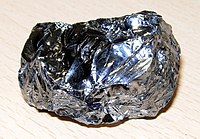
Photo from wikipedia
Bone mineral carbonate content assessed by vibrational spectroscopy relates to fracture incidence, and mineral maturity/ crystallinity (MMC) relates to tissue age. As FT-IR and Raman spectroscopy become more widely used… Click to show full abstract
Bone mineral carbonate content assessed by vibrational spectroscopy relates to fracture incidence, and mineral maturity/ crystallinity (MMC) relates to tissue age. As FT-IR and Raman spectroscopy become more widely used to characterize the chemical composition of bone in pre-clinical and translational studies, their bone mineral outcomes require improved validation to inform interpretation of spectroscopic data. In this study, our objectives were (1) to relate Raman and FT-IR carbonate:phosphate ratios calculated through direct integration of peaks to gold-standard analytical measures of carbonate content and underlying subband ratios; (2) to relate Raman and FT-IR MMC measures to gold-standard analytical measures of crystal size in chemical standards and native bone powders. Raman and FT-IR direct integration carbonate:phosphate ratios increased with carbonate content (Raman: p < 0.01, R2 = 0.87; FT-IR: p < 0.01, R2 = 0.96) and Raman was more sensitive to carbonate content than the FT-IR (Raman slope + 95% vs FT-IR slope, p < 0.01). MMC increased with crystal size for both Raman and FT-IR (Raman: p < 0.01, R2 = 0.76; FT-IR p < 0.01, R2 = 0.73) and FT-IR was more sensitive to crystal size than Raman (c-axis length: slope FT-IR MMC + 111% vs Raman MMC, p < 0.01). Additionally, FT-IR but not Raman spectroscopy detected differences in the relationship between MMC and crystal size of carbonated hydroxyapatite (CHA) vs poorly crystalline hydroxyapatites (HA) (slope CHA + 87% vs HA, p < 0.01). Combined, these results contribute to the ability of future studies to elucidate the relationships between carbonate content and fracture and provide insight to the strengths and limitations of FT-IR and Raman spectroscopy of native bone mineral.
Journal Title: Calcified tissue international
Year Published: 2021
Link to full text (if available)
Share on Social Media: Sign Up to like & get
recommendations!